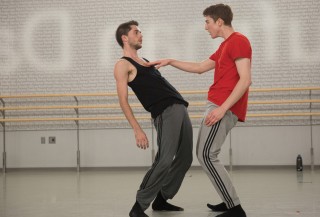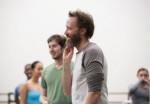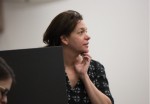Title

Juilliard fourth-year dancers Conner Bormann and Riley O'Flynn
(Photo by Rosalie O'Connor) More Photos »While the annual New Dances concert is generally described as dances by four “up-and-coming” choreographers, New Dances: Edition 2016 offers the work of four highly respected artists who, though in various stages of their choreographic careers, have been commissioned and presented, lauded and awarded. In short, the four—John Heginbotham, Katarzyna Skarpetowska, Pam Tanowitz, and Matthew Neenan—have decidedly arrived.
Choreographer and Juilliard alumnus John Heginbotham is working with the first-year dancers.
(Photo by Rosalie O'Connor)Body
To select choreographers for New Dances, which he instituted a decade and a half ago, Lawrence Rhodes, the artistic director of the division, watches videos from choreographers and attends concerts weekly looking for good matches for Juilliard. Once he's found potential matches, he prefers to follow the artists' development for a few years, waiting for the moment when he senses a deeper understanding reflected their work. His goal is to bring them to Juilliard when they're ripe to explore and able to offer a clear-eyed point of view to the class.
For a typical dance company commission, a choreographer must work quickly (which is to say affordably)—generally just two or three weeks of full days are allotted to create a 20-minute dance. That's not the case with New Dances, where the choreographers start working with the dancers in October, two months before show time. But despite the early start, the dancers only have a limited time with the choreographers—rehearsals take place just three days a week, after classes are done for the day. The prolonged gestation could be frustrating for a choreographer used to working more briskly, but it can also permit more reflection—and that extended reflection shows. While some creations are more successful than others from a choreographic perspective, over the decade and a half since Rhodes instituted New Dances, many of the works created have had a life after Juilliard as they've been bought and presented by major companies.
While generations of choreographers know Rhodes as a mentor, he doesn't dictate to the New Dances choreographers about how they should work or cast or what their piece should look like. The only parameters they're given are to use all the dancers in the class, whether in one or more casts, and that the dance be ready to present to the public by opening night.
The choreographers meet the dancers for the first time at the first rehearsal and then determine how they'll uncover and use the talent they find in the room. Without the constraint of pre-casting, the dancers have the opportunity to respond to the choreographer and the movement without the pressure of their previous experience influencing how they're seen. That is, the dancers themselves have a hand in their casting by virtue of their effort in the studio and willingness to understand the point of view the choreographer offers.
Though John Heginbotham (BFA '93, dance) and Katarzyna Skarpetowska (BFA '99, dance) graduated from Juilliard before Rhodes came on as artistic director, he watched their choreographic careers with interest long before offering them commissions for, respectively, the first- and second-year classes. In selecting them, Rhodes said he appreciated the two “for their individual artistic points of view” and noted that both had “absorbed the best lessons about musical values and spatial structures from the masterful artists with whom they worked so closely”—Heginbotham with Mark Morris and Skarpetowska with David Parsons and Lar Lubovitch ('64, dance).
Heginbotham's initial plan for the first-year students was to work with contemporary music, but a search for a suitable piece led into what he called a “YouTube vortex” in which he discovered the Schubert String Quintet in C. It inspired “a flood of movement images” that he combined with the “generous and enthusiastic” presence of the dancers to shape a work, called First, in which everyone is featured with duets and trios and sections of the full company.
Rhodes cited Skarpetowska's “outgoing energy as a terrific match for the class” as part of the reason he asked her to work with the second-years. Her response? “I thought you'd never ask!” She'd been excited about New Dances since its inception, particularly the opportunity for all dancers to perform in a major concert—a notable change from her time at Juilliard, when only upperclassmen were considered for performing and then they were selected by audition. Skarpetowska came into the process with an idea for the arc of the piece and having selected the music, Chopin's Cello Sonata in G Minor. Speaking before the rehearsals had started she said that once the dancers were in front of her, she would “color in the lines,” allowing the dance to lead her where it needs to go. Called The Saloneers, it will have a simple set designed by Clifton Taylor to evoke the intimacy of the Paris salons Chopin frequented.
Pam Tanowitz, who's working with the third-years, previously choreographed for New Dances in 2011; in choosing her again, Rhodes praised her “unusual gifts” for structure and “uncanny sense of what the music is doing.” While some New Dances choreographers don't develop ideas until they've seen the dancers, Tanowitz generally does a lot of preliminary work, finding inspirations in her head and physically working them out alone in a studio before starting to work with dancers. Starting with simple phrases, she mutates them—rearranging and reversing, cutting and connecting—until a sense of meaning and inevitability emerges from the abstraction. She takes traditional forms and shows them in a new way by playing with the execution, timing, and intention of codified technical steps. This can make the movement challenging, but she says Juilliard dancers “know how to do everything and when they don't, they know how to work it out.” Tanowitz set her piece, thunder rolling along afterward, to Andrew Norman's The Companion Guide to Rome, a string trio in seven sections.
When selecting a choreographer to work with the senior class, Rhodes reviews the students' previous three years to see what challenges they need for their last commission. He selected Neenan for his vast experience with professional companies and clear and specific way of working. After two previous New Dances commissions (2006 and 2010), Neenan knows how to pace himself—how long he has to play and experiment, and when he needs to shape the dance toward its final iteration. While he previously took advantage of Juilliard's offer of live music, for this year's piece, Walk Me Through, Neenan was inspired by singer-songwriter Rufus Wainwright, whose music he describes as “beautiful and dark in a way that's raw and satisfying.” Also, he says, “it's closer music”—very appropriate since the senior class will indeed close the New Dances program.













